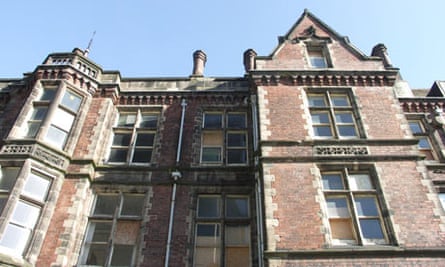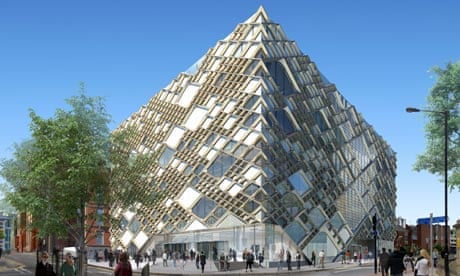The protection of historic buildings is a success of modern Britain. There have been absurdities, where pernickety preservationists have fretted over the precise intentions of bygone Cuthberts and Augustuses, and the conservation of works of concrete brutalism has led to special contortions. But in recent decades most of what should have stayed has stayed, and the guardians of heritage have learned to allow intelligent adaptation. Two per cent of the nation's buildings are listed, which is hardly a brake on change and growth.
Which makes the fate of the Edwardian wing of the Jessop hospital in Sheffield disturbing. This is a listed building which, according to policies until now, should certainly be kept, and for which there is no overwhelming reason to destroy. The worthy bodies and officials who are consulted on such matters said it should be kept. Yet thanks to an alliance of Sheffield University, Sheffield city council and the communities secretary Eric Pickles, it is doomed. And if it goes, a lot of similar buildings could go too.
The Jessop hospital was the result of the philanthropy of the steelmaker Thomas Jessop, created to serve the women of Sheffield. It was made in two parts, one Victorian and the other Edwardian, both to the designs of the leading local architect, John Dodsley Webster. The style is neo-Gothic, going on neo-Tudor, with decorative stonework of a kind that is hard to reproduce today. It's an important survivor of the much battered fabric of Sheffield's heyday.
English Heritage considers it "significant" for its part in advancing women's health care. The local council's policy was clear, that development here should "respect" the listed buildings, and the Victorian part of the hospital has been restored and converted into a home for the university's music department.
Then the university decided it wanted a new £81m building for its engineering faculty, and that it would go on a site which is mostly empty, but includes the Edwardian wing at its edge. They hired RMJM, the practice renowned less for its design brilliance than for hiring the notoriously pension-starved ex-banker Fred Goodwin as a consultant, and for paying their staff late. RMJM came up with a big box, garnished with a facade in aluminium, apparently composed by some computer jockey out of misunderstood borrowings from Rem Koolhaas and Herzog and de Meuron.

The old building was to be obliterated – collateral damage of a design that shows no interest or ability in adapting itself to anything around it. The new design finds room for a large atrium and external plaza, but not for the listed building. When they first saw the design the council's planning officers called it "unacceptable", "alien" and "ungainly", "with an overly-complex external envelope that has no relationship with its setting". They opposed "the loss of an important grade II listed building" that is "an irreplaceable resource". The surviving Victorian wing of the hospital "would appear weak and out of place against the backdrop of a new building".
Council officials have to use measured terms, so this was planner speak for "unmitigatedly revolting and cack-handed". They were not alone: the Victorian Society, the Sheffield Sustainable Development and Design Panel, the Ancient Monuments Society, the Society for Protection of Ancient Buildings, the Sheffield Conservation Advisory Group and the Hallamshire Historic Buildings Society all opposed the project. It seemed that the only people who liked the scheme were the university and RMJM.
Then, somewhat mysteriously, the planning officers softened their line. Councillors granted planning permission last December. As justification they cited a clause in the National Planning Policy Framework, a creation of the current government, which says that the loss of a listed building can only be allowed "in order to achieve substantial public benefits". The university argues that the project will create "around 500 jobs during the construction period", will "inject around £44.5m into Sheffield's economy" in its first year, and "almost £21m" a year after that.
They are right, in that the university is a major employer in a city that has lost its old industries, and that the engineering department is one of its successes. What is false is the notion that it's impossible to have both the new building and the old – that you can have either engineers or history but not both. With a bit more skill and effort RMJM could fit both on the site, and Sheffield as a whole is not short of empty space – it is not some fevered Hong Kong, where every scrap of land has to be intensively developed. Nor is this about building costs, as RMJM's fancy facade will spend money that could otherwise be spent on the Edwardian wing.
The argument that destruction is justified by the jobs created during construction is especially tendentious: all building work employs people, so any planning application might be justified on this basis. At the same time, the restoration of old buildings creates jobs, which could be used as an argument for preservation. It's a meaningless point, but it was good enough for the planning committee of Sheffield city council. It was handy for the university, which is behaving less like a public institution than the big business it now is, flexing its muscles like the mill owner in a mill town.
It was also good enough for Eric Pickles, whose task it was to decide whether to call in the council's decision for a public inquiry. Last week he declared that there was no need for such a thing. In doing so he set the definition of "substantial public benefits" extremely broadly – the implication is that any developer can claim that their projects create jobs, and without trying too hard to prove that a listed building is not viable, can go ahead and demolish it.

Comments (…)
Sign in or create your Guardian account to join the discussion